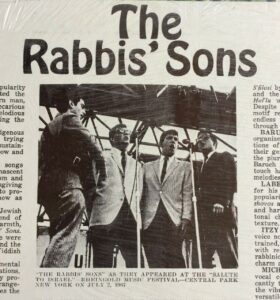Raboyseyee and Ladies,
A big mazel tov to Danielle and Yonatan Schwartz, children of Barbara and Shimmy Schwartz and Blimi and Ben Chesir upon the recent birth and bris this morning -with the Ois in attendance- of a new son and grandson. Welcome to the world Natan Eliyahu (Elijah Seymour); may you bring much joy to your family always.
Mazel tov to Fran and Steven Hoffman and to Dina and Zev Raden upon the birth of a baby grandson born to their children Ruthie and Netanel Raden. Welcome to the world baby Raden who was named this morning at the bris over in Riverdale. May he be a source of joy only to this entire family.
Mazel tov again to us, Lisa and Yitz Grossman upon the engagement and the Lechaim later this evening -at our home- in honor of the engagement of our daughter Alex to Yaakov Rabi.
———————————————————————————————————————
The Ever Shrinking Observance of Sefira
The heylige Internet, despite the consternations of certain chasiddishe rebbes, keeps on giving. Certain rabbis forbid their constituents from using it; they say it’s treif (not kosher) and could lead to many bad things including mixed dancing and other illicit relationships, many of which are spelled out in this week’s parsha(s). Somehow, they turn a blind eye when the organizations and or institutions they run, lead or own need to conduct an on-line campaign to raise money. The bottom line: business is business; business certainly overrides logic and any other concerns they have.
Ober, the heylige internet is mamish great! Daily emails remind us to daven mincha. We are bombarded with different parsha thoughts; it’s givaldig. Several times daily, the heylige Ois is the recipient of WhatsApp messages reminding him to count the sefira. Even with those, if one is not in shul participating with a minyan, at times, we tend to forget. Our sages of yore knew this and developed some arcane system to continue counting but without a brocho. Why that makes any sense, ver veyst? Shoin! That and many other questions will be -so they tell us- answered by the Moshiach when he arrives one day. Until then, we suck it up and follow the rules.
Welcome then to the 21st day of the Yimay Hasfira (Sefiras Ho’oimer), and taka it would appear that we are making good and steady progress as we power through the 49 day count-up (yes, up not down) to the great Yom Tov of Shovuois, the holiday we celebrate because on that day we received the heylige Toirah. And when was that? For those counting, the RBSO gave the heylige Toirah to Moishe and His Chosen People, the Yiddin, on Har Senai some 3,333 years ago, mamish seven weeks after the Yiddin left Mitzrayim. The heylige Toirah was given on the 6th day of the month Sivan, in the year 2448 of the Jewish calendar.

Ober we ask azoy: is 21 days in the sefira close to the end? Don’t we have another four weeks of sefira observances and restrictions yet to come? We will address that below. Though the heylige Toirah was taka received -as a wedding gift- mamish 50 days after the Yiddin-to-be left Mitzrayim, sadly and regrettably, but 40 days later the Yiddin were already off the derech (path) and partied hearty with the Eygel (golden calf), causing Moishe to break the Luchis containing the Ten Commandments. Some say the celebratory dancing was mixed and was also followed by other behaviors the RBSO was not very fond of, if you chap. Moishe had to beg the RBSO for mercy on behalf of the Yiddin and start the process all over again. Eventually, he came back with new tablets on Yom Kippur. The eygel continues to haunt the Yiddin ad-hayoim hazeh (until today). Efsher you recall that just last week, one medrish told us that the reason the RBSO introduced Tzora’as (skin afflictions) was because of the eygel, the sin that keeps on punishing. The RBSO, as we have discussed many times in the past, is a very jealous G-d and abhors –more than anything, including more than forbidden relations which are center stage this week- disloyalty.
Interestingly, Parshas Achrei Mois, the first half of this week’s double-header which also includes Kedoishim, will discuss the role of the koihen Godol (high priest) on that day of Yom Kippur. He was one busy fellow beseeching the RBSO for forgiveness on behalf of the Yiddin and himself. How could he adequately represent the Yiddin if he himself was a sinner? Ver veyst? The bottom line: no one is perfect; we should never expect it and we should be willing to forgive assuming whomever pissed us off asks for forgiveness and says he is sorry. Therein lies the rub: many have difficulty getting those words out.
That being said, Achrei Mois is efsher more famous for the list of forbidden familial and other sexual relationships; which would you rather read about? The two goats involved in the service with one going to a mysterious place called Azozale, whatever and wherever that is? Or, the myriad relationships the Yiddin seemingly partook of and efsher enjoyed prior to the RBSO shutting the door on over 20 of them? Shoin: don’t answer that! Veyter.
Mamish just above, we asked azoy: Are we almost half-way -or more- through the mourning period for the 24,000 -according to some- students of Rebbe Akiva who -according to some- perished during that time period? Not! Based on the calendar of upcoming weddings the heylige Ois and eishes chayil will be attending with great joy in the next few weeks. It’s mashma (apparent) that we are more than 90% done with sefira, the 49-day period between Pesach and Shovuois when we are, or used to be, in a state of mourning. And the question is azoy: Are we -though the official calendar tells us that it will be another 27 days until Shovuis, done mourning? Do we not mourn for the group of hundreds or maybe thousands who maybe passed away after the 33rd day of the Oimer? Seemingly we don’t! Why not? Ver veyst? Were they bad guys? Were those who died between Rosh Chodesh Iyar and Lag Bo’oimer more special?
Is it the Ois’s imagination or is sefira and its observance mamish declining rapidly and maybe even over, done, and kaput? How much more can it shrink? Does business override customs that date back hundreds of years? How far are we from weddings and bar mitzvahs on Tisha Be’av mamish? Ver veyst? Altz kint (as a young child) and even until the Ois was in his mid-30’s, he recalls that the observance of sefira was taka strict. We mourned for Rebbe Akiva’s talmidim. We did? Ober didn’t all the yeshivas back then close for the day and take the kinderlach to the park where we would play with our fallenboigens (bows and arrows) while the rebbe was trying to shoot his? They did! Is a day off from yeshiva the way we mourn? Is a day in the park spent playing games how we showed respect to the dead students? That being stated, we didn’t listen to music, barber shops were closed, and caterers went on vacation.

There were zicher no weddings, engagement parties, shul dinners, or any other festivities. Ober in hyntige tzytin (in our days), a nechtiger tug; it’s epes punkt farkert (just the opposite). But for a tiny window of efsher 16-17 days, there are parties and events daily. Many shuls schedule their dinners during sefira. The bottom line: business is business and there’s no business like shul business! Another bottom line: shuls need money daily; sefira cannot interfere and azoy geyt iz (that’s just how it goes). Another bottom line: kosher caterers were not very happy about being closed for 49 days and mistama they lobbied their local rabbis and shoin: slowly over time we seem to have forgotten about Rebbe Akiva’s students. Besides, if they taka didn’t respect one another and weren’t so nice to one another -so we were taught as a possible rationale for their untimely deaths- should we be crying for them so many years later? Ver veyst?
And taka today, in our times, with all the sefira exemptions including the 14 days leading up to Roish Choidesh, Roish Choidesh itself – sometimes two days- Yom Ha’atzmaut, (Day of Independence), Lag Bo’oimer, the days following, the three days leading to Shovuois, the allowance to make a le’chaim anytime, and others, the observance of sefira and its restrictions is down to a very manageable 14-17 days. Nu, efsher we should count sefira ober without a brocho on nights that we attend a simcha, ver veyst. In any event, it’s avada always good to attend a simcha and mazel tov to us -we are hosting an engagement party tonight -seemingly allowed by all rabbis so long as music is not introduced- and to others who have a bris to celebrate, a l’chaim to make or attend, and any other simcha!
As to Rebbe Akiva’s students, some argue that his students died because they taka were not such nice guys. Efsher they knew how to learn but epes were lacking in derech eretz (respect for one another). Interestingly enough, loving another Jew is discussed in the back end of the double header, in Kedoishim, where among the 51 mitzvis found (the second largest amount of any parsha consisting mostly of the do-not-do variety), is the great mitzvas ah-say (to do) of Vi’ohavto Lirayacho Komicho- (to love your friend as you love yourself) -see Vayikra 19:18. Shoin, this isn’t a heter (permission granted) to literally love your neighbor as you do yourself, if you chap, especially his wife, chazir that you are. That discussion for another day and parsha; let us stay focused please. The same Rebbe Akiva is quoted by many and his words describing this particular mitzvah as being a great principle of the Toirah were also put to song by the Rabbi’s Sons, Album number 1 way back in the late 1960’s. It’s mamish kideye (worthwhile) to find and listen to this great song, a classic mamish. Speaking of the Rabbi’s Sons, here’s a shtikel factoid you mistama did not know. The heylige Ois himself produced their final album, a reunion album, many years after the amazing group disbanded. Fact checking? Check it out here: https://en.wikipedia.org/wiki/The_Rabbis%27_Sons

So happens that several of their songs continue to be sung and played 54 years later. Speaking of this concept, and before we get to some straight talk about forbidden sexual encounters and relationships, let’s quickly chazir a few interesting approaches to these and other words found in the parsha. Lommer lernin a few words likovid (in honor of) the shabbis tish.
The literal translation of “Love your neighbor just as much as yourself” can be very confusing. Many wax fancy about their true meaning, ober said the Baal Shem Tov so gishmak azoy: The words are the basis for fulfilling all the mitzvis in the heylige Toirah that pertain to mankind. If one is able to look at another person as a man who has faults very similar in nature to his or her own, ultimately, one will not have grudges against other people. Nice theory, difficult to put into practice.

Shoin, lommer lernin three words found just one posik earlier (19:17) which tell us azoy: “Hoicheach Toicheach Es Amisecha,” (You shall reprove your fellow). The word “Hoicheach” is repeated for emphasis, ober why? And why would the heylige Toirah which does not repeat concepts or words double up on this language? Said Reb Dovid Feinstein mamish so gishmak azoy: This emphasis is not meant for the one who sinned –mistama you. Instead, it’s meant to deliver an important message to the one doing the reproving, the one calling you out. The person reproving “the good friend” must understand that before he can reprove someone else, he must first reprove himself. It is impossible to reprove someone else and make an impact on the sinner unless the sinner knows that the only motive is to help him out, which can only happen if the person reproving is him or herself careful in the mitzvah. Many medroshim will teach us that Aharoin Hakoihen had this unique ability. He was known for making peace between those arguing and fighting. He internalized all the lessons and virtues of the heylige Toirah and was able to reprove the sinners effectively. Avada it’s good to be like Aharoin who despite having lost two sons in this week’s parsha was able to internalize the lesson being taught by the RBSO and move on.
Though Achrei Mois does extensively cover the Yom Kippur service as performed by the Koihen Godol, one could easily get the impression that these two parshas in the heylige Toirah are primarily about sexual relations, all of the forbidden variety. One wouldn’t be all that wrong. There is avada other content and every word of the heylige Toirah is zicher holy, meaningful and special. Ober, none of it will chap you quite the same way, and the major point of both parshas is that one shouldn’t be chapping where one isn’t supposed to. Shoin! In both, the heylige Toirah presents the laws of arayos (forbidden sexual relationships) and not the as-of late very popular dish known as arayis. It outlines -in great detail- all the familial relationships which render sexual contact forbidden, as well as other forbidden relations, including homosexuality (unless, as we have discussed in the past, one applies for the ‘Rebbe in Yeshiva exemption’ also later extended to others who work with boys), relations with animals (especially vilde chayis, if you chap), and so on. Acharei-Mois (Vayikro 18) specifically delineates the actual prohibitions of arayis and warns us not to violate them. And if you want to get scared straight, read and study Parshas Kedoshim (chapter 20) wherein the heylige Toirah prescribes the punishment for each of the violations listed in the preceding parsha, and then some. It’s not a pretty picture and zicher you’d be much better off going home to the eishes chayil, no matter how challenging the thought, if you chap. Or maybe not!

And before some of you wisenheimers start sending mail accusing the heylige Ois of writing ’schmutz’, let me kindly point you to the text of the heylige parsha, the Rashi, the heylige Gemora, and myriad medroshim who, like the Ois, were trying to make sense of these very detailed encounters one should avoid. Keep in mind: the Ois is merely -for the most part- repeating what other very holy people wrote and whose writings, despite their content, seemingly made their way into such places as the heylige Gemora, the Mikro’ois Gedoils versions of the Chumish (mandated by every Yeshiva high school – boys and girls) and many other very choshova seforim. If they were able to cover these topics without being lambasted, why not the Ois? What’s taka pshat? Many wonder why these forbidden relations are spelled out in such detail in both parshas. Wasn’t one parsha enough to cover the material? Or, why not just tell us that a man can only be with his eishes chayil and that’s it? Why the theatrics? What the hec is going on here?
Nu, some say that there is a Talmudic principle which states “ein oinshim elah im kein mazhirim” (A punitive action is not meted out for the transgression of a prohibition unless there is a prior scriptural warning.) Others -not just oisvorfs- suggest that the RBSO wanted to give the Yiddin some time to wean themselves off myriad such relationships they had efsher enjoyed while in Mitzrayim or even in the Midbar, pre Matan Toirah and gave the Yiddin a shtikel quiet period to clean up their acts. No wonder many were reluctant to leave Egypt! Some ask why these ‘don’t-dos’ aren’t then listed respectively in any one parsha? The unusual placement of these sexual transgressions begs for further interpretation and avada we should dig deeper, why not?
And taka many, many commentators asked the same questions. It’s the Ois’s tafkid (charge) to try to answer these questions without sweeping these gehoibene (elevated) concepts under the proverbial rug and to shed some light onto the matter. Nu, let’s read what some have to say about these. And since both parshas cover these relationships, at times, we’ll just lump them together.
Just for educational purposes, you should know that the first three aliyas of Achrei Mois are all about Yom Kippur and the Avoida (the service) of the koihen godol (high priest) on that day, but is that really vichtig on April 27th? Shoin, there is taka plenty of time until Yom Kippur and the thought of doing tshuva is nowhere near the radar; on the other hand, forbidden relations are always nearby. Nu, where were we? Let’s get back to Arayis because avada kuli-alme-loi-p’ligi (in Gemora parlance: no one would argue), this topic is always sadly relevant, and, avada, one that you could all use some chazora (review) on.
Some ask yet another shaylo (question). The list of prohibitions in Parsha #1 of this week’s laining commences with illicit familial relations (mishpocho incest) and concludes with deviant relations and acts (adultery, homosexuality, bestiality, say it’s not so please). Ober, in Parsha #2, it’s punkt farkert (opposite) where deviant relations and acts come first, if you chap, followed by incestuous relations. Vus epes the change in order? Avada only people who mamish look into these words so deeply and chazir them over and again would notice these subtle differences. Seemingly, there aren’t many such people.
Is incest taka so giferlich? Well, not according to everyone, and in fact, says the Seforno (18:6) azoy: marriage to one’s close relatives would seem to be ideal. The shared values, backgrounds, and personalities should combine to produce wonderful children. As evidence for this claim, he cites no lesser a personality than Amrom, Moishe’s father, who married his Tanta (aunt) Yoicheved (seemingly mutir (permissible) prior to the giving of the Toirah). And what came forth from this union? No lesser a giant of a person by the name of Moishe Rabaynu. And let’s not forget his siblings Aharoin and Miriam who between them, get mentioned in every single parsha in the heylige Toirah from their emergence on the scene until the last parsha in the gantze Toirah. Shoin, case closed! Nu, given such kinderlach from this union, why did the RBSO change His mind and declare these relationships out of bounds? Doesn’t it taka make sense to marry relatives who understand our own shtick, minhogim, mishigassin, desires, and idiosyncrasies?
Answers the Seforno his own question and says azoy: had it been the case that the intentions of the couple were solely leshaim shomayim (noble purpose), such unions would indeed be successful and their children would be exceptional. Ober, in reality, it’s nebech not the case because human nature shows that people are but chazerim, for the most part. Along with the RambaM and Ibn Ezra, the Seforno explains that the RBSO ideally prefers that people be completely focused on and dedicated to serving Him, ober because we are human, He had no choice but to permit marital relations. However, in an effort to minimize sexual relations (even of the permitted variety), the Toirah forbade relations with all of a person’s close relatives. Because the person -say you, by way of example- would so frequently be surrounded by them, and this regular contact could easily lead to constant involvement in your base (sub) human desires and avada this could lead to mixed dancing, use of the internet, and worse. What could be worse, ver veyst? There is more: since such desires and acting upon them, would distract us from focusing on elevating ourselves and achieving our true spiritual purposes, the heylige Toirah therefore prohibited these relationships. The bottom line: not all elevations, if you chap, are kosher.
Ober the RambaN wasn’t very tzifridin (satisfied) with this pshat and said azoy: a man is biblically permitted to marry as many wives as he wants, something which should clearly be forbidden if the Toirah’s goal was to minimize his involvement in marital relations to free him to pursue spiritual endeavors. In other words: intimacy is a good thing. He argues that it’s mamish illogical that marrying one’s daughter or sister should be punished so severely when somebody else, lemoshol (by way of example) Shlomo Hamelech married 1,000 wives with impunity. Nu, it’s avada good to be the king! As a result, the RambaN suggests that the entire concept of forbidden relationships falls into the category known as chukim and avada you recall from our previous learning, that chukim are mitzvis which we perform only because that’s what the RBSO ordered. If He ordered them, mistama there’s good and sound logic for them. And the fact that your little heads, if you chap, can’t internalize these concepts, does not exonerate you from violating these laws. Moreover, who says we have to chap and understand all that the RBSO asks of us? Our job is to believe and follow orders. Especially these, since they carry the death penalty in various forms; yikes.
Ober why taka are unions between close relatives off-limits? Some say it’s to prevent genetic disorders caused by inbreeding. Ober it’s clear from looking at the expansive list of no-nos that the heylige Toirah wasn’t really concerned about such issues. Avada we know that genetic risks aren’t increased when marrying a stepmother, a sister-in-law, or the wife of one’s uncle and still it’s a no- no (unless of course these same people were already previously related). In fact, a man may not marry his shvigger (mother-in-law) or grandmother-in-law even after he divorces his wife, or his wife dies. Shoin! Not that there is much demand for such unions, ober the heylige Toirah wasn’t taking any chances. Basically, the mother-in-law status (but not always the relationship) stays intact forever: once a shvigger, always a shvigger; it’s hands off, no matter how desirous -even for revenge for giving you her tuchter (daughter).
Ober said the RambaM azoy: the heylige Toirah forbade intimate relations – including marriage – with close relatives because of the regularity of contact with them. Had the Toirah permitted relations with relatives, people would engage excessively in intercourse, and, as the RambaM writes earlier, the Toirah seeks “to inculcate the lesson that we ought to limit sexual intercourse altogether, hold it in contempt, and desire it very rarely.” To this end, the Toirah said osur (no) to relations with those who would otherwise be available for this purpose at all times. And the Toirah forbade marriage with these relatives too, in order to render these relatives entirely and permanently forbidden, such that relations with them would not be desired at all. It epes appears that many of the heylige neshei chayil (wives) understood and chapped the essence of the RambaM’s writings and taka do their part to limit dramatically physical contact. They -post marriage- desire such contact only occasionally, efsher rarely. Nu, efsher that’s why taka the RBSO did allow (and still does) a man to have multiple wives. Between a dozen or more, most men should be tzifridin (satisfied), though it took at least 18 for Dovid Hamelech and epes 1,000 for Shlomo Hamelech. I repeat: it’s good to be the king!
A gittin Shabbis-
The Heylige Oisvorfer Ruv
Yitz Grossman
